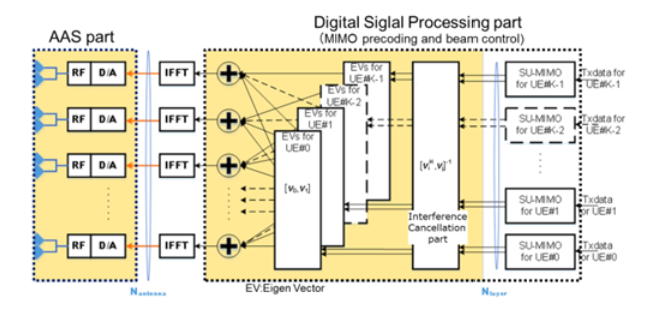A prototype 500 massive-element active antenna system (AAS) targeting 5G in the 28GHz band was just announced by Japan’s NEC. NEC says that the prototype is capable of achieving 1 kilometer distance communications in 16 directions, at a speed of 30 Gbps or faster per cell achieving a spectral efficiency 20 times greater than LTE with low power consumption.
mmWawe and 5G, a Marriage Made in Heaven?: With the requirement in mind that 5G mobile networks are to provide multi-gigabit communication services such as HD video, it seems but natural to look at mmWave spectrum where bandwidth is plentiful. Currently the mmWave bands that the industry is looking at are the 28 GHz band, the 38 GHz band, the 60 GHz band, and the E-band (71–76 GHz and 81–86 GHz). Due to the fundamental differences between mmWave communications and existing other communication systems operating in the microwaves band (e.g., 2.4 GHz and 5 GHz), there are many challenges in physical (PHY) layer, medium access control (MAC) layer, and routing/network layers.
The Challenge of mmWaves in 5G: The high propagation loss, directivity, sensitivity to blockage, and dynamics of a mobile mmWave channel require new thoughts and insights into the architectures and the protocols to cope with these challenges. The major ones are to cope with unfavorable propagation conditions such as large path loss in LoS (Line of Sight) / NLoS (Non Line of Sight), signal blockage due to atmospheric absorption, and blocking objects attenuation and mobility. In addition, these challenges should be overcome in a cost and energy effective manner.
Technology Solutions to mmWave work for 5G: The widely accepted solution is adaptive beamforming equipped with very large antenna arrays. The combination of these two technologies meets the following objectives:
- Adaptive beamforming in different propagation conditions, NLoS/LoS in the presence of mobility
- Support for multiple users
- Robustness against signal blocking
- High data rates and low-latencies
- Robust hardware capable of high frequencies and ultra wide bandwidths
NEC AAS for 5G
NEC’s Adaptive Antenna Array: NEC’s 500 elements Active Antenna System (AAS) acts as the front end for basestations that support the 28GHz band, and meets the requirements of 5G. NEC has conducted simulation trials of its newly developed AAS with beamforming technology for transmitting radio waves in multiple directions (to objects) while intensively and simultaneously using many antenna elements. NEC reports achieving up to one kilometer in long-distance communication in 16 respective directions, at a speed of 30Gbps or faster per cell, in the 28 GHz band, and achieving a spectral efficiency 20 times greater than LTE.

In addition, original NEC reports saving several dozen watts of power and reducing the size by approximately 50%. In addition, “NEC has achieved the creation of a power-saving and compact-size AAS by leveraging circuit design technologies such as component mounting and heat radiation, which it has accumulated over the years through the development of microwave communication systems on high frequency bands.”
Source: NEC
Find us also in Facebook, Google+, Instagram, Medium, Twitter
Partnerships, Inquiries: socialmedia(at)5g-magazine.com
© 2016 www.5g-magazine.com, www.elenaneira.com – All rights reserved. Use of this Web site signifies your agreement to its Terms & Conditions.


